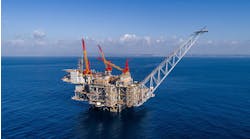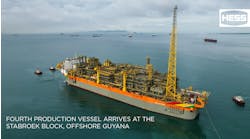PRODUCTION TECHNOLOGY: Solving cavitation and sand erosion problems in separator level control valves
Oil-water separator level control valves require continuous maintenance, due to an environment that is more destructive than many other valve applications. Over the years, service life of a few weeks between complete rebuilds was common, but this has changed. Velocity-control technology, aimed at two root causes - the implosive force of cavitating water and the erosive effect of concentrated sand driven by high-velocity water - has solved the problem in many cases. - A sectional elevation of the new choke valve with major components identified.
At the Statfjord B platform in the Norwegian sector of the North Sea, the output of some wells - crude oil, gas, produced water (with a specific gravity of about 1.03), and sand - flow into a single separator tank where the constituents separate out in layers according to their specific gravities. Each well may not have enough sand production to cause an operational problem, but the combined sand production is more than enough to cause severe erosion of the level-control valve trim.
Previously, two full-capacity valves in parallel (one operating and one being rebuilt) were used to control the flow of up to 1,500 cu meters/hour from the separator tank pressure of 65 BarG down to 3.5 BarG at a temperature of 75° C.
To combat the combined effects of erosive sand and water cavitation, these parallel level control choke valves were recently replaced. When combined with advanced materials technology, cavitation erosion and rapid sand erosion were eliminated through a unique velocity-control design. The unique multistage valve trim employed balanced and severe-service control.
Multistage velocity control
This multistage trim controls internal fluid velocity by using a stack of tortuous-path disks. The fluid is forced through a series of pressure-reducing, right angle turns. In this way, flow velocities are reduced by over 75% compared to single-stage plug and seat, ported cage, or drilled-hole gage designs. This design prevents damaging cavitation. - Individual disks that make up the solid tungsten-carbide velocity-control trim.
When liquid pressure is reduced to or below its vapor pressure, flashing and bubble-formation occurs. In conventional valves, fluid enters at pressure P1 and at velocity V1. As it moves through the redu-ced area of the valve trim, it accelerates to velocity V2. The static pressure drops to P2 - a level at or below the fluid's vapor pressure Pv, at which the fluid boils.
Any conventional valve will encounter this problem due to the uncontrolled velocities in the vena contracta (smallest flow area of the valve). As the fluid moves out of the throat of the valve, pressure recovery begins, converting kinetic energy back to potential energy. Full recovery to downstream pressure is indicated at P3 and velocity V3.
Cavitation forms
When the recovery pressure exceeds the fluid's vapor pressure, Pv, the just-formed bubbles collapse, causing cavitation. The energy released in this event creates local surface stresses in excess of 1,400 MPa which can fracture the surface of even the hardest trim materials very rapidly. - Comparative PV/time graphic that demonstrates how the absence of flashing and resultant cavitation is achieved in velocity-control valve trim.
Severe-service control valves are now designed specifically for multistage pressure reduction, such as those now in service at the Statfjord B platform. The controlled-velocity trim design prevents vena contracta pressures from dropping to the vapor pressure Pv, thus avoiding the possibility of cavitation and resulting rapid valve-trim damage.
Materials construction
The trim and plug in this separator level-control choke valve is made from solid tungsten carbide. The seat ring is provided with a tungsten-carbide venturi allowing for a controlled, erosion-resistant expansion into the choke outlet and downstream piping.
After six months (twice the previous record and four times the past typical life), the valve was removed for inspection. Parts were measured and photographed prior to valve reassembly. The valve was reinstalled and returned to service for another eight months.
Based on data collected during this inspection, the design was slightly modified to achieve a two-year service interval - nearly 20 times previously experienced. Separator level-control choke valves on the other platforms are now being replaced.


